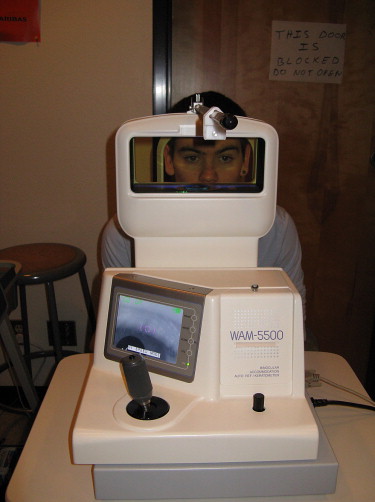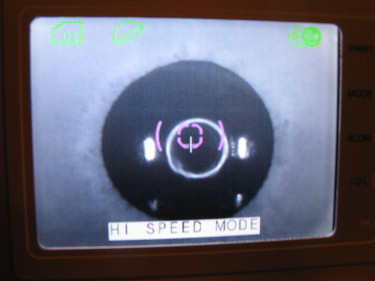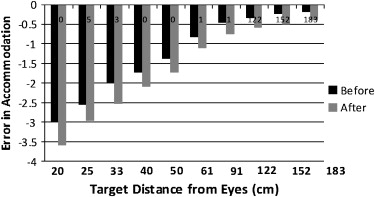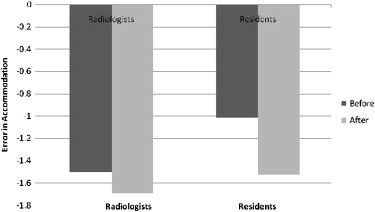Rationale and Objectives
The authors hypothesized that the current practice of radiology produces oculomotor fatigue that reduces diagnostic accuracy.
Materials and Methods
Testing this hypothesis required an ability to measure eyestrain. This capability was developed by measuring the visual accommodation of radiologists before and after diagnostic viewing work using an autorefractor that was capable of making multiple measurements of accommodation per second. Three radiologists and three residents focused on a simple target placed at near to far distances while accommodation was measured. The target distances varied from 20 to 183 cm from the eye. The data were collected prior to and after a day of digital diagnostic viewing.
Results
The results indicated that accommodation at near distances was significantly worse overall compared to far distances and was significantly worse after a day of digital reading at all distances.
Conclusions
Because diagnostic image interpretation is performed at near viewing distances, this inability to maintain focus on an image could affect diagnostic accuracy. As expected, younger residents had better accommodative accuracy than older radiologists.
Routing imaging studies to radiologists over digital networks increases access to subspecialists and previous imaging studies. Reports are transported more rapidly, and productivity is increased. However, many digital displays still offer less contrast than film and reduced spatial resolution, information used by the visual system to regulate image focus, single vision, and the direction of gaze. Digital display could increase the strain on radiologists’ eyes and reduce their performance. Our overall hypothesis was that radiology displays produce oculomotor fatigue that reduces diagnostic accuracy. The first step was to discover whether measureable eyestrain results from reading radiology displays. In this initial study, we measured the visual accommodation of radiologists before and after diagnostic viewing work.
Close work of any kind for hours on end can overwork the eyes, resulting in eyestrain (known clinically as asthenopia) . With nonmedical computer displays, just 4 hours is sufficient to produce asthenopia , and there is some evidence that prolonged computer use may even induce myopia in many computer users . Oculomotor fatigue caused by close work with digital displays may add to the effects of extended workdays and aging eyes . Although eyestrain has not been studied in radiology, we do have preliminary data showing that radiologists report increasingly severe symptoms of eyestrain, including blurred vision and difficulty focusing (see Table 1 ), as they read more imaging studies . The symptoms were assessed for film viewing only, digital viewing only, and a combination of film and digital viewing. Symptoms were worst when radiologists switched between film and digital viewing throughout the day and were less when only film examinations were read .
Table 1
Correlation Between Subjective Fatigue, How Long, and How Many Cases Radiologists Read
“How Long” Correlation “How Many” Correlation Variable_R__P__R__P_ Headache 0.24 .09 0.43 <.002 Eyestrain 0.43 <.002 0.48 <.001 Difficulty focusing 0.38 <.005 0.45 <.001 Blurred vision 0.34 <.02 0.42 <.002
Get Radiology Tree app to read full this article<
Get Radiology Tree app to read full this article<
Get Radiology Tree app to read full this article<
Materials and methods
Get Radiology Tree app to read full this article<
Get Radiology Tree app to read full this article<
Get Radiology Tree app to read full this article<
Get Radiology Tree app to read full this article<
Results
Get Radiology Tree app to read full this article<
Get Radiology Tree app to read full this article<
Get Radiology Tree app to read full this article<
Get Radiology Tree app to read full this article<
Discussion
Get Radiology Tree app to read full this article<
Get Radiology Tree app to read full this article<
Get Radiology Tree app to read full this article<
Get Radiology Tree app to read full this article<
References
1. Ebenholtz S.M.: Oculomotor systems and perception.2001.Cambridge University PressNew York
2. MacKenzie W.: On asthenopia or weak-sightedness. Edinburgh J Med Surg 1843; 60: pp. 73-103.
3. Sanchez-Roman F.R., Perez-Lucio C., Juarez-Ruiz C., Velez-Zamora N.M., Jimenez-Villarruel M.: Risk factors for asthenopia among computer terminal operators. Salud Publica Mexico 1996; 38: pp. 189-196.
4. Komiushina T.A.: Physiological mechanisms of the etiology of visual fatigue during work involving visual stress. Vestnik Oftalmologii 2000; 116: pp. 33-36.
5. Mutti D.O., Zadnik K.: Is computer use a risk factor for myopia?. J Am Optom Assoc 1996; 67: pp. 521-530.
6. Heron G., Charman W.N., Gray L.S.: Accommodation responses and ageing. Invest Ophthalmol Vis Sci 1999; 40: pp. 2872-2883.
7. Krupinski E.A., Kallergi M.: Choosing a radiology workstation: technical and clinical considerations. Radiology 2007; 242: pp. 671-682.
8. Sterner B., Gellerstedt M., Sjöström A.: Accommodation and the relationship to subjective symptoms with near work for young school children. Ophthalmic Physiol Opt 2006; 26: pp. 148-155.
9. Iwasaki T., Tawara A., Miyake N.: Reduction of asthenopia related to accommodative relaxation by means of far point stimuli. Acta Ophthalmol Scand 2005; 83: pp. 81-88.
10. Pigion R.G., Miller R.J.: Fatigue of accommodation: changes in accommodation after visual work. Am J Optom Phys Opt 1985; 62: pp. 853-863.
11. Murata A., Uetake A., Otsuka M., Takaswaw Y.: Proposal of an index to evaluate visual fatigue induced during visual display terminal tasks. Intl J Hum Comput Int 2001; 13: pp. 305-321.
12. National Transportation Safety Board: Evaluation of US Department of Transportation efforts in the 1990s to address operator fatigue. Safety Report NTSB/SR-99/01, PB99-917002, notation 7155.1999.National Transportation Safety BoardWashington, DC
13. Occupational Safety and Health Administration. Computer workstations: monitors. Available at: http://www.osha.gov/SLTC/etools/computerworkstations/components_monitors.html#Viewing%20Distance . Accessed January 30, 2009.
14. Krupinski E.A.: Visual scanning patterns of radiologists searching mammograms. Acad Radiol 1996; 3: pp. 137-144.
15. Krupinski E.A., Tillack A.A., Richter L., et. al.: Eye-movement study and human performance using telepathology virtual slides: implications for medical education and differences with experience. Hum Pathol 2006; 37: pp. 1543-1556.
16. Mello-Thoms C., Ganott M., Sumkin J., et. al.: Different search patterns and similar decision outcomes: how can experts agree in the decisions they make when reading digital mammograms?.Krupinski E.A.International Workshop on Digital Mammography 2008, Lecture Notes on Computer Science 5116.2008.Springer-VerlagBerlin, Germany:pp. 212-219.



